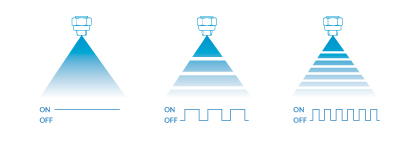Electric spray nozzles for coating
Electrically actuated spray nozzles have an integrated electric shut-off valve within the nozzle body. The valve is very close to the nozzle orifice allowing for near instantaneous spray shut-off. These nozzles can be cycled on and off up
to 150 times per second. When connected to a suitable control panel, such as out FlexFlow system, incredibly precise control of the spraying process can be achieved.
Pulse width modulation
If electrically actuated nozzles are cycled on and off very rapidly the resulting spray will still behave as if it is completely continuous. In reality, the spray is being pulsed but because the pulsing is so fast it acts like a continuous spray.
What this means is that the dosing from the nozzle can be controlled by varying the lengths of the on/off pulses. For example, a 66% on to 33% off very rapid pulse cycle would result in a 33% reduction in the spray delivered.

If the fluid pressure is kept constant the flow from a nozzle set can be varied using this technique without changing any of the other fluid properties like droplet size. As such, the same set of nozzles can be programmed for variable spray duties
for different product runs.
Precision control
When connected to the FlexFlow or other control system, precise control can be achieved. The FlexFlow system can receive inputs from a variety of different proximities, heat or other sensors. When programmed correctly it can instantly deliver
the correct spray exactly where it is needed. This can reduce waste spraying and improve product quality.
Products
There are three products in our electric nozzle offering. A hygienic electrically actuated nozzle, an industrial non-hygienic variant and the FlexFlow control system. Full details can be found by clicking on the boxes below for data sheets
on each product.